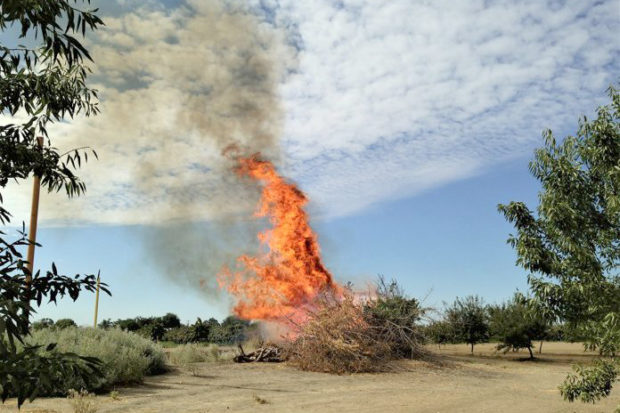
By Nayamin Martinez
At the beginning of March 2021, Laura heard a loud thunder, like the sound of a gun being fired. When she checked where the noise came from, she realized that there were “explosions” coming out of cans that were part of the pile of wood and trash that the farm across the street was burning.
Laura began noticing the piles of agricultural waste months earlier, and she was genuinely concerned with the potential health effects to her family. Especially to her daughter, who has asthma and had been admitted to the ER three years earlier because of an asthma attack that followed an agricultural burn.
When this incident occurred, Laura did not know what to do, but something was different this time around.
At the end of 2019, Laura joined the Warriors for Clean Air project, a program led by the LEAP Institute in partnership with Comite Civico del Valle and the Central California Environmental Justice Network (CCEJN) with funding from the California Air Resources Board (CARB).
This project teaches community members the health impacts of air pollution and, with residents of Kings County and west Fresno County, is developing a community air monitoring network (CAMN). The CAMN will include 15 low-cost sensors that will give community members real-time data on local levels of PM2.5 so that they can take preventive measures to protect their health.
The elementary school in Raisin City, the community where Laura lives, is one of the locations for these low-cost monitors.
Laura learned not only where to access local air quality data but also that the San Joaquin Valley Air Pollution Control District (“Air District”) is the agency that regulates air quality in the Central Valley and that has the authority to allow or prohibit ag burns.
When Laura began noticing the piles of prunings, she contacted LEAP and the CCEJN and asked if the Air District could stop the burn. But the response was that the Air District can only “inform” the farmer about the incentive program that he could access to chip the prunings instead of burning them.
That response did not stop Laura. She attended the Air District meeting in December and then the CARB meeting in February.
After hours of patiently waiting for her turn to speak, Laura, through an interpreter, explained to the board members of each agency why she thinks it is time to stop allowing ag burns: because she has a daughter with asthma and she is pregnant and fearful of having a second child with that same health condition and because she feels that, so far, the agencies have worried only about the money of the ranchers rather than the health of community members.
Unfortunately, Laura’s voice and the voice of many other advocates were not enough to end the harmful practice of openly burning ag waste. CARB decided to give the Air District another extension of four years, until Jan. 1, 2025, before all ag burning will be prohibited. Between now and then, the Air District will facilitate a phaseout of agricultural burning that includes prohibiting burning in large agricultural operations and prohibiting burns of certain crops (e.g., citrus).
Following its tradition of being overly concerned with the industry’s well-being, the Air District announced that it needs funding in the order of $15 million–$30 million annually to support the transition from ag burning to other alternatives such as soil incorporation.
We can just hope that the Air District would show the same level of concern for the residents who are affected by ag burning. Allowing the extension of ag burning for another four years is a plain example of environmental racism.
This practice does not affect all residents in the Central Valley equally; rather, it mostly affects low-income people of color who live near the farms that are still using this dirty practice. In these homes, children are studying at home because of Covid and many of these children suffer from asthma.
Yet, the economic analysis made by the Air District does not account for the health costs of families having to miss days of work to take care of sick kids, the money that schools stop receiving for the same reason or the cost of the healthcare system for those who need to use the ER when having an asthma attack.
Families like Laura’s and many others cannot wait four more years. The ag industry and the Air District had 18 years to prepare for this day. Yes, that is not a typo, 18 years.
It was in 2003 that then-State Senator Dean Florez from Shafter authored SB 705, which intended to phase out open agricultural burning in the San Joaquin Valley between 2005 and 2010. Since SB 705 was signed into law, the Air District has requested, and CARB has provided, five postponements of the SB 705 requirements. Now CARB has given the Air District another four-year postponement.
As environmental justice advocates, we are not done. We will continue pushing for protective measures.
We will demand that the Air District impose a requirement on farmers to offer proper notification in multiple languages to the affected residents.
We will demand that the Air District inform every farmer that calls their office for a burn permit about the incentive program and that they raise the $750 that they are currently charging per acre for the burn permit and use those funds to incentivize more ecological alternatives, especially among small farmers of color.
*****
Nayamin Martinez is the executive director of the Central California Environmental Justice Network.
